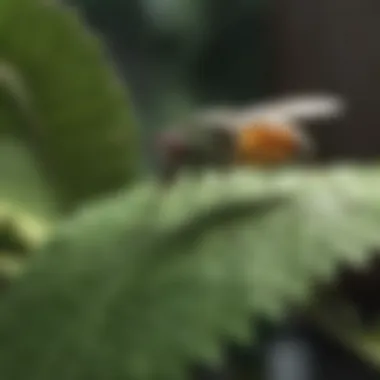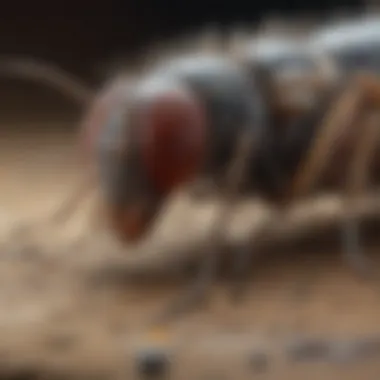Effective Strategies for Eliminating Gnats in Your Living Space


Gnats making their way into your living space can be a pesky nuisance to deal with. This guide will lead you through effective strategies to combat these tiny pests, from identifying the type of gnat to implementing practical solutions for their eradication.
Understanding the Types of Gnats
The first step in dealing with a gnat infestation is to understand the different types of gnats that may be invading your home. By identifying the specific species of gnat, you can tailor your eradication methods more effectively. Fungus gnats, drain flies, and fruit flies are among the common culprits that might be lurking in your house.
Fungus Gnats
Fungus gnats are often found around houseplants and thrive in damp soil. These small, dark-colored insects can quickly multiply and become a nuisance. Effective methods to combat fungus gnats include drying out the soil, using natural predators like beneficial nematodes, or applying bacillus thuringiensis.
Drain Flies
Drain flies, also known as sewer gnats, are typically found near drains and sewage systems. These tiny flies breed in organic matter within drains and pipes. To eliminate drain flies, it is essential to unclog and thoroughly clean drains, remove any standing water, and utilize drain cleaners or biological drain treatments.
Fruit Flies
Fruit flies are attracted to ripened fruits, vegetables, and fermenting products. To effectively tackle a fruit fly infestation, make sure to eliminate or refrigerate exposed food sources, set up vinegar traps, and maintain cleanliness in kitchen areas. By targeting the breeding sites and food sources, you can substantially reduce the fruit fly population in your home.
Implementing Practical Solutions
Once you have assessed the type of gnat infestation in your home, it is time to implement practical solutions to eradicate these pests effectively. Utilizing natural remedies like apple cider vinegar traps, vacuuming affected areas, and sealing potential entry points can help in reducing gnat populations. Additionally, ensuring proper waste management, maintaining cleanliness, and fixing any leakages or standing water issues are crucial steps in preventing gnat infestations in the future.
Conclusion
Dealing with gnats can be a challenging task, but with the right knowledge and strategies, you can successfully eliminate these unwelcome guests from your living space. By understanding the types of gnats, implementing targeted solutions, and adopting preventative measures, you can maintain a gnat-free environment in your home.
Understanding Gnats
Understanding Gnats section is crucial in this article as it sets the foundation for addressing gnat infestations effectively. By unraveling the intricacies of gnat behavior and characteristics, homeowners, interior design enthusiasts, party hosts, and gardening aficionados can gain valuable insights into combating these pesky creatures. A deep comprehension of gnat types, breeding habits, and environmental preferences is essential to devise tailored eradication strategies.
Types of Gnats
Distinguishing Characteristics


Distinguishing Characteristics play a pivotal role in recognizing and dealing with different gnat species. Understanding key traits such as size, color, wing pattern, and behavior patterns aids in precise identification, crucial for targeted extermination efforts. The ability to differentiate between various gnat species enables homeowners to apply suitable control measures effectively.
Biology and Habits
Biology and Habits shed light on the intricate lifecycle and behavioral patterns of gnats. Delving into their reproductive cycles, preferred breeding sites, feeding habits, and response to environmental conditions offers valuable insights for implementing preventive measures. Recognizing how gnats interact with their surroundings is fundamental in devising long-term pest management strategies.
Reasons for Gnat Infestation
Moisture and Humidity Levels
Moisture and Humidity Levels are major contributors to gnat infestations within households. Excess moisture provides an ideal breeding ground for gnats, facilitating rapid population growth. Understanding the correlation between humidity levels and gnat prevalence is essential for adopting measures to reduce moisture accumulation and deter gnat infestations effectively.
Organic Matter Presence
Organic Matter Presence serves as a beacon for gnats seeking breeding sites and food sources. The decomposition of organic materials releases scents that attract gnats, leading to infestations. By addressing the presence of organic matter through proper waste disposal and cleanliness practices, homeowners can significantly mitigate gnat attraction and breeding opportunities.
Detecting Gnat Presence
In the realm of pest control within residential spaces, the task of detecting gnat presence holds a paramount significance. Gnats, being tiny and elusive insects, can quickly multiply in favorable conditions, making early detection crucial in preventing a full-blown infestation. By paying attention to the subtle signs of their existence, homeowners can take proactive measures to address the issue promptly.
Signs of Gnats in Your House
Small Flying Insects
Small flying insects, often mistaken for fruit flies or mosquitoes, signify the potential presence of gnats. Their minuscule size and erratic flight patterns set them apart, hovering around ripe fruits and damp areas. This distinct behavior not only indicates a gnat infestation but also underscores the need for thorough inspection and eradication methods. While these insects might seem insignificant individually, their cumulative presence can lead to a bothersome situation.
Gathering around Food Sources
The phenomenon of gnats gathering around food sources serves as a telltale sign of their infestation in households. Gnats are attracted to decaying organic matter, fermenting liquids, and overripe fruits, creating an environment conducive to their proliferation. Observing these pests swarming near kitchen counters, trash cans, or compost bins underscores the urgency of addressing sanitation practices and eliminating potential breeding grounds. Recognizing this behavioral pattern aids in pinpointing areas that require targeted intervention to disrupt the gnat lifecycle effectively.
Locating Gnat Breeding Sites
In the mission to combat gnat invasions, a critical step involves identifying their breeding sites within the household premises. Gnats lay eggs in moist, organic substrates, necessitating a thorough search for these concealed habitats. By focusing on common areas such as drains, potted plants, or damp corners, homeowners can uncover potential hotspots for gnat reproduction.
Inspecting Common Areas


The meticulous inspection of common areas sheds light on gnat breeding grounds that often go unnoticed. From leaky pipes to soiled kitchen sponges, any damp and decaying matter can serve as a prime location for gnat larvae development. Understanding the significance of inspecting these spaces enables individuals to disrupt the breeding cycle and curb infestation spread effectively.
Identifying Potential Nesting Spots
Gnats prefer secluded spaces for nesting, making it imperative to identify potential spots for their proliferation. Dark, humid areas like crawl spaces, trash receptacles, and plant containers offer ideal conditions for gnat habitation. By recognizing these specific locations and implementing targeted eradication methods, homeowners can prevent gnat resurgence and maintain a gnat-free environment.
Eliminating Gnats
In the multifaceted realm of gnat management, the paramount focus lies on eradication measures. The importance of eliminating these pesky insects cannot be overstated in the context of maintaining a harmonious living environment. Gnats not only pose a nuisance through their presence but can also escalate into a full-blown infestation if left unchecked. Thus, understanding effective elimination strategies is crucial in reclaiming your home from these unwelcome intruders. By exploring natural remedies and chemical solutions, you pave the way for a gnat-free abode.
Natural Remedies
Apple Cider Vinegar Trap:
Diving into the realm of natural remedies, the Apple Cider Vinegar Trap emerges as a stalwart in gnat elimination. This method revolves around luring gnats with the enticing aroma of apple cider vinegar, trapping them effectively. The simplicity of this solution is its allure, requiring minimal effort for maximum impact. Gnats are irresistibly drawn to the trap, leading to their capture and consequent reduction in population within your living space. While this method may lack the immediacy of chemical solutions, its non-toxic nature makes it a popular choice for those prioritizing environmental and health considerations. Embracing the Apple Cider Vinegar Trap as a gnat eradication tool can yield notable results without introducing harmful substances into your living environment.
Essential Oils Repellent:
Exploring the realm of natural solutions further, Essential Oils Repellent emerges as a formidable contender in the fight against gnats. The key characteristic of essential oils lies in their potent fragrance, which acts as a deterrent for gnats and other pests. By leveraging the scents of essential oils such as lavender, peppermint, or eucalyptus, you create an inhospitable environment for gnats, prompting them to seek shelter elsewhere. This natural repellent not only serves as an effective gnat deterrent but also infuses your living space with pleasant aromas, enhancing the overall ambiance. However, while essential oils boast natural origins, their efficacy may vary depending on individual preferences and gnat species. Understanding the intricacies of essential oils as gnat repellents enables homeowners to make informed decisions tailored to their specific needs.
Chemical Solutions
Insecticides:
Delving into the domain of chemical gnat elimination, insecticides emerge as a potent weapon against these persistent pests. The key characteristic of insecticides lies in their rapid and targeted action against gnats, swiftly reducing their numbers within your living space. By employing insecticides, homeowners can achieve quick and tangible results in gnat eradication, especially in cases of severe infestations. While chemical solutions offer expedited relief, it is essential to exercise caution during their application, ensuring the safety of both residents and pets. Balancing the efficacy of insecticides with responsible usage underscores the significance of integrating chemical solutions into a comprehensive gnat elimination strategy.
Fumigation Options:
Venturing into the realm of comprehensive gnat extermination, fumigation options emerge as a robust choice for combatting widespread infestations. The key characteristic of fumigation lies in its ability to penetrate hidden gnat breeding grounds, eradicating these pests at the source. By enveloping your living space in gnat-targeted fumigants, you eliminate not only adult gnats but also their eggs and larvae, disrupting the gnat life cycle effectively. While fumigation presents a potent solution for severe gnat infestations, homeowners must exercise caution and adhere to safety protocols during the fumigation process. Embracing fumigation options as a gnat elimination strategy requires meticulous planning and execution to ensure optimal results while safeguarding the well-being of inhabitants.
In the realm of household nuisances, gnats stand out as persistent pests that can quickly take over your living space. As you navigate the challenges gnats pose, understanding the critical aspect of Preventing Gnat Reappearance surfaces as a key pillar in reclaiming your home. By delving into strategies to avoid the resurgence of these tiny invaders, homeowners equip themselves with proactive measures that fortify their defenses against future infestations.
Maintaining Cleanliness


Proper Waste Disposal
Embarking on the quest to combat gnats necessitates a keen focus on Proper Waste Disposal. This entails implementing a structured waste management system that reduces potential gnat breeding grounds within your home. The essence of Proper Waste Disposal lies in its ability to eliminate organic matter sources that attract and sustain gnat populations. By segregating and disposing of waste promptly, you disrupt the gnat lifecycle, hindering their proliferation. Embracing Proper Waste Disposal emerges as a linchpin in fortifying your household's gnat defenses, rendering your living environment less hospitable to these unwanted intruders.
Regular Cleaning Routines
Integrating Regular Cleaning Routines into your household regimen emerges as a pivotal strategy in the battle against gnat reinfestation. By upholding consistent sanitation practices, you mitigate gnat-attracting elements, such as food residues and spills, which serve as magnets for these pesky insects. The crux of Regular Cleaning Routines lies in their role of upholding hygiene standards that deny gnats the sustenance they seek. Adhering to scheduled cleaning protocols not only deters gnat activity but also cultivates a pristine living environment that minimizes the likelihood of recurrent infestations. Incorporating Regular Cleaning Routines elevates your gnat deterrence efforts, fostering a hostile setting for these unwelcome intruders.
Controlling Moisture Levels
Repairing Leaks
An integral facet of preempting gnat reappearance involves addressing and rectifying leaks within your home. Repairing Leaks serves as a fundamental step in curtailing moisture accumulation, which serves as a breeding ground for gnats. The crux of Repairing Leaks stems from its capacity to thwart the damp environments conducive to gnat proliferation. By promptly fixing leaks, you curb moisture levels, creating an inhospitable habitat for gnats to thrive. Embracing Repairing Leaks as a preventive measure bolsters your household's defenses against gnat resurgence, instating a barrier against their return.
Using Dehumidifiers
In the realm of moisture management, employing Dehumidifiers emerges as a potent tool in your arsenal against gnat reoccurrence. The essence of Using Dehumidifiers lies in their efficacy in extracting excess moisture from the air, thereby depriving gnats of the damp conditions they crave. By maintaining optimal humidity levels through dehumidification, you create an unfavourable setting for gnats to inhabit, impeding their ability to establish colonies. Incorporating Dehumidifiers into your home environment signifies a proactive approach to moisture control, fortifying your gnat deterrent measures and tipping the scales in your favour against potential infestations.
Seeking Professional Help
Seeking professional help when dealing with gnat infestations in your home is a crucial step towards effective eradication. Professional exterminators have the expertise and tools required to address gnat issues comprehensively, ensuring long-term results. By enlisting the services of pest control professionals, homeowners can save time and effort, avoiding ineffective DIY methods that can prolong the infestation. The knowledge and experience of pest control experts enable them to identify the root causes of gnat problems and tailor treatment plans accordingly, offering a targeted and efficient approach to pest management.
When to Call Pest Control
Persistent Infestations
Persistent gnat infestations pose a significant challenge to homeowners due to their stubborn nature. These infestations keep recurring despite repeated DIY interventions, signaling the need for professional assistance. Pest control professionals excel in handling persistent infestations by deploying advanced techniques and products that effectively eradicate gnats at all life stages. The strategic application of specialized treatments ensures thorough gnat elimination, addressing the underlying issues to prevent future outbreaks. Seeking professional help for persistent infestations guarantees a lasting solution, securing a gnat-free environment for your household.
Overwhelming Gnat Population
An overwhelming gnat population indicates a severe infestation that requires immediate attention from pest control experts. The sheer number of gnats can disrupt daily activities, compromise hygiene standards, and pose health risks to residents. Professional exterminators specialize in managing overwhelming gnat populations through integrated pest control measures that target adult gnats as well as their larvae. Their systematic approach involves assessing the extent of the infestation, implementing customized treatment plans, and monitoring the results to ensure complete eradication. Choosing professional help for overwhelming gnat populations is essential for restoring the safety and comfort of your home environment.
Choosing Reliable Exterminators
Researching Service Providers
Researching service providers is a fundamental step in selecting reliable exterminators for gnat control. Homeowners should delve into the backgrounds of pest control companies, assessing their track records, certifications, and customer reviews. Reliable exterminators stand out for their positive reputation, proven expertise in gnat management, and transparent communication throughout the treatment process. By researching service providers diligently, homeowners can entrust their gnat infestation issues to capable professionals who deliver effective and sustainable results.
Assessing Treatment Plans
Assessing treatment plans proposed by exterminators is vital to ensuring successful gnat eradication. Professional pest control companies customize treatment strategies based on the specific gnat species infesting the premises, the level of infestation, and any environmental considerations. Effective treatment plans should incorporate a combination of targeted insecticides, habitat modifications, and preventive measures to eliminate gnats and deter future invasions. Homeowners benefit from assessing treatment plans in terms of their safety, efficiency, and long-term gnat control outcomes, making informed decisions to safeguard their households from pest-related disruptions.







